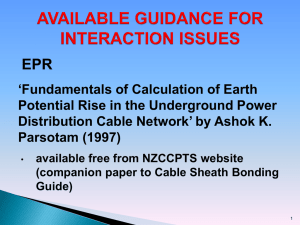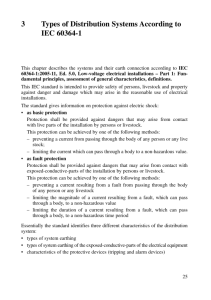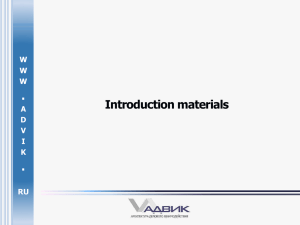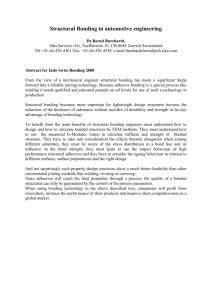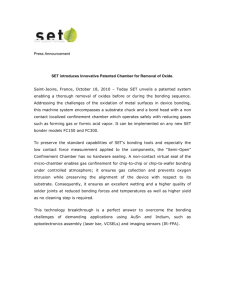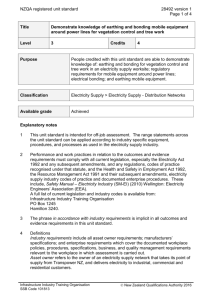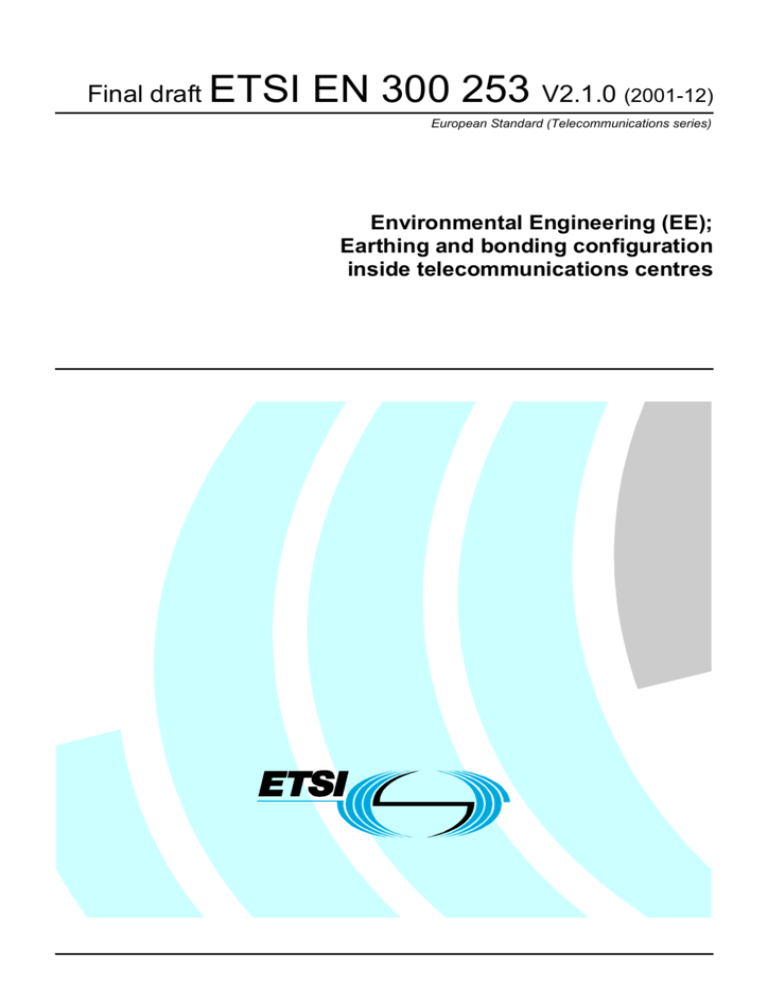
Final draft ETSI
EN 300 253 V2.1.0 (2001-12)
European Standard (Telecommunications series)
Environmental Engineering (EE);
Earthing and bonding configuration
inside telecommunications centres
2
Final draft ETSI EN 300 253 V2.1.0 (2001-12)
Reference
REN/EE-02009
Keywords
bonding, earthing, equipment practice
ETSI
650 Route des Lucioles
F-06921 Sophia Antipolis Cedex - FRANCE
Tel.: +33 4 92 94 42 00 Fax: +33 4 93 65 47 16
Siret N° 348 623 562 00017 - NAF 742 C
Association à but non lucratif enregistrée à la
Sous-Préfecture de Grasse (06) N° 7803/88
Important notice
Individual copies of the present document can be downloaded from:
http://www.etsi.org
The present document may be made available in more than one electronic version or in print. In any case of existing or
perceived difference in contents between such versions, the reference version is the Portable Document Format (PDF).
In case of dispute, the reference shall be the printing on ETSI printers of the PDF version kept on a specific network drive
within ETSI Secretariat.
Users of the present document should be aware that the document may be subject to revision or change of status.
Information on the current status of this and other ETSI documents is available at
http://portal.etsi.org/tb/status/status.asp
If you find errors in the present document, send your comment to:
editor@etsi.fr
Copyright Notification
No part may be reproduced except as authorized by written permission.
The copyright and the foregoing restriction extend to reproduction in all media.
© European Telecommunications Standards Institute 2001.
All rights reserved.
ETSI
3
Final draft ETSI EN 300 253 V2.1.0 (2001-12)
Contents
Intellectual Property Rights ................................................................................................................................4
Foreword.............................................................................................................................................................4
Introduction ........................................................................................................................................................5
1
Scope ........................................................................................................................................................6
2
References ................................................................................................................................................6
3
Definitions and abbreviations...................................................................................................................7
3.1
3.1.1
3.1.2
3.2
4
4.1
4.2
4.3
5
5.1
5.2
5.3
5.4
5.5
6
6.1
6.2
6.3
6.4
Definitions..........................................................................................................................................................7
IEC definitions (by IEC 60050 numbers) .....................................................................................................7
Telecommunication definitions ....................................................................................................................8
Abbreviations .....................................................................................................................................................9
General requirements ...............................................................................................................................9
Safety from electrical hazards ............................................................................................................................9
Signal reference..................................................................................................................................................9
EMC performance ..............................................................................................................................................9
Requirements on bonding networks .......................................................................................................10
Bonding configurations ....................................................................................................................................10
CBN within a telecommunication building ......................................................................................................10
BN within a telecommunication system...........................................................................................................10
Merging of CBN and MESH-BNs ...................................................................................................................13
Cabling within and between BNs .....................................................................................................................13
Requirements for power distribution......................................................................................................13
DC power distribution of secondary supply .....................................................................................................13
DC power distribution of tertiary supplies .......................................................................................................13
AC mains distribution and bonding of the protective conductor......................................................................14
AC power distribution from tertiary power supply ..........................................................................................14
Annex A (normative):
Rationale about CBN co-ordination.............................................................17
Annex B (informative):
Rationale about the integration of the DC return conductor into the
merged CBN/MESH-BN ...............................................................................18
Annex C (informative):
Bibliography...................................................................................................20
History ..............................................................................................................................................................21
ETSI
4
Final draft ETSI EN 300 253 V2.1.0 (2001-12)
Intellectual Property Rights
IPRs essential or potentially essential to the present document may have been declared to ETSI. The information
pertaining to these essential IPRs, if any, is publicly available for ETSI members and non-members, and can be found
in ETSI SR 000 314: "Intellectual Property Rights (IPRs); Essential, or potentially Essential, IPRs notified to ETSI in
respect of ETSI standards", which is available from the ETSI Secretariat. Latest updates are available on the ETSI Web
server (http://webapp.etsi.org/IPR/home.asp).
Pursuant to the ETSI IPR Policy, no investigation, including IPR searches, has been carried out by ETSI. No guarantee
can be given as to the existence of other IPRs not referenced in ETSI SR 000 314 (or the updates on the ETSI Web
server) which are, or may be, or may become, essential to the present document.
Foreword
This European Standard (Telecommunications series) has been produced by ETSI Technical Committee Environmental
Engineering (EE), and is now submitted for the ETSI standards One-step Approval Procedure.
The present document has been produced within the framework of the following considerations:
a) centralized telecommunication equipment is generally installed in telecommunication centres and held in racks,
cabinets or other mechanical structures;
b) the existing ITU-T and CCIR Recommendations and CENELEC standards in such matters do not ensure the
required standardization at the equipment level;
c) network operators and equipment providers agreed to standardize on a bonding configuration that facilitates:
-
compliance with functional requirements including Electromagnetic Compatibility (EMC) aspects of
emission and immunity;
-
compatible building and equipment provisions;
-
installation of new telecommunication centres as well as expansion or replacement of installations in existing
telecommunication centres with equipment coming from different suppliers;
-
a structured installation practice;
-
simple maintenance rules;
-
contracting on a common basis;
-
cost effectiveness in development, manufacturing, installation and operation.
Proposed national transposition dates
Date of latest announcement of this EN (doa):
3 months after ETSI publication
Date of latest publication of new National Standard
or endorsement of this EN (dop/e):
6 months after doa
Date of withdrawal of any conflicting National Standard (dow):
6 months after doa
ETSI
5
Final draft ETSI EN 300 253 V2.1.0 (2001-12)
Introduction
The present document addresses earthing and bonding of telecommunication equipment in telecommunication centres
in relation to safety, functional performance and EMC.
Information regarding the general principles on earthing for telecommunication sites has been published by the ITU-T
in the handbook on "Earthing of telecommunication installations" (see annex C). ITU-T Recommendation K.27 deals
with bonding configurations and earthing inside a telecommunication building. One bonding configuration only is
selected from ITU-T Recommendation K.27 (CBN/MESH-BN) and tailored to the present document.
ETSI
6
1
Final draft ETSI EN 300 253 V2.1.0 (2001-12)
Scope
The present document applies in telecommunication centres and similar installations to the bonding network of the
building, the bonding network of the equipment, and the interconnection between these two networks. It contributes to
the standardization of telecommunication and datacom equipment installation.
It also co-ordinates with the pre-conditions of the installation to achieve the following targets:
-
safety from electrical hazards;
-
reliable signal reference;
-
satisfactory Electromagnetic Compatibility (EMC) performance.
A defined bonding configuration down to the equipment level shall facilitate the installation, operation and maintenance
of telecommunication centres in telecommunication buildings or similar installations independent of the equipment
supplier.
The specification of telecommunication and datacom equipment and of the pre-conditions of installation are subject to
agreement of the parties (e.g. the supplier and the purchaser). Annex A can be used in the procedure to achieve
agreement.
The present document does not cover safety and EMC aspects of the equipment. Those aspects are covered by other
relevant standards.
The present document does not apply to the installation of telecommunication and datacom equipment in locations other
than telecommunication centres, e.g.:
-
smaller telecommunication equipment inside a subscriber's building;
-
subscriber line terminal equipment.
NOTE:
2
Earthing and bonding of equipment installed in locations other than telecommunication building is
covered by EN 50310 [8].
References
The following documents contain provisions which, through reference in this text, constitute provisions of the present
document.
• References are either specific (identified by date of publication and/or edition number or version number) or
non-specific.
• For a specific reference, subsequent revisions do not apply.
• For a non-specific reference, the latest version applies.
[1]
CENELEC HD 384.4.41: "Electrical installation of buildings - Part 4: Protection for safety Chapter 41: Protection against electric shock".
[2]
CENELEC HD 384.5.54: "Electrical installation of buildings - Part 5: Selection and erection of
electrical equipment - Chapter 54: Earthing arrangements and protective conductors".
[3]
EN 60950: "Safety of information technology equipment".
[4]
EN 41003: "Particular safety requirements for equipment to be connected to telecommunication
networks".
[5]
IEC 60050: "International Electrotechnical Vocabulary".
[6]
IEC 60050-604: "International Electrotechnical Vocabulary. Chapter 604: Generation,
transmission and distribution of electricity - Operation".
ETSI
7
Final draft ETSI EN 300 253 V2.1.0 (2001-12)
[7]
IEC 60050-826: "International Electrotechnical Vocabulary. Electrical installations of buildings".
[8]
EN 50310: "Application of equipotential bonding and earthing in buildings with information
technology equipment".
[9]
IEC 61024-1: "Protection of structures against lightning - Part 1: General principles".
3
Definitions and abbreviations
3.1
Definitions
For the purposes of the present document, the following terms and definitions apply.
The following definitions with respect to earthing and bonding are introduced by the IEC 60050 [5] and are used within
the present document to maintain conformity.
3.1.1
NOTE:
IEC definitions (by IEC 60050 numbers)
IEC 60050 [5] references are given in parentheses (see IEC 60050-604 [6] and IEC 60050-826 [7]).
earth (826-04-01): conductive mass of earth, whose electric potential at any point is conventionally taken as equal to
zero
earthing conductor (826-04-07): protective conductor connecting the main earthing terminal or bar to the earth
electrode
earth electrode (826-04-02): conductive part or a group of conductive parts in intimate contact with and providing an
electrical connection with earth
earthing network (604-04-07): part of an earthing installation that is restricted to the earth electrodes and their
interconnections
equipotential bonding (826-04-09): electrical connection putting various exposed conductive parts and extraneous
conductive parts at a substantially equal potential
equipotential bonding conductor (826-04-10): protective conductor for ensuring equipotential bonding
IT: See IEC 60364-3.
main earthing terminal (826-04-08): terminal or bar provided for the connection of protective conductors, including
equipotential bonding conductors and conductors for functional earthing if any, to the means of earthing
Neutral conductor (N) (826-01-03): conductor connected to the neutral point of a system and capable of contributing
to the transmission of electrical energy
PEN conductor (826-04-06): earthed conductor combining the functions of both protective conductor and neutral
conductor
Protective conductor (PE) (826-04-05): conductor required by some measures for protection against electric shock by
electrically connecting any of the following parts:
-
exposed conductive parts;
-
extraneous conductive parts;
-
main earthing terminal;
-
earth electrode;
-
earthed point of the source or artificial neutral.
TN-C: See IEC 60364-3.
ETSI
8
Final draft ETSI EN 300 253 V2.1.0 (2001-12)
TN-S: See IEC 60364-3.
TT: See IEC 60364-3.
3.1.2
Telecommunication definitions
The following definitions, specific to telecommunication installations and not covered by the IEC 60050 [5], are used
within the present document. Correspondence to ITU-T Recommendation K.27 (see annex C) is indicated as
appropriate.
bonding mat: essential means to provide a SRPP by a discernible, nearly regular mesh structure
NOTE:
The bonding mat may be located either below or above a collection of equipment constituting a system
block.
Bonding Network (BN), (ITU-T Recommendation K.27): set of interconnected conductive structures that provides an
"electromagnetic shield" for electronic systems and personnel at frequencies from Direct Current (DC) to low Radio
Frequency (RF)
NOTE:
The term "electromagnetic shield" denotes any structure used to divert, block or impede the passage of
electromagnetic energy. In general, a BN need not be connected to earth but all BNs considered in the
present document will have an earth connection.
Common Bonding Network (CBN), (ITU-T Recommendation K.27): principal means for effective bonding and
earthing inside a telecommunication building
NOTE:
It is the set of metallic components that are intentionally or incidentally interconnected to form the
principal BN in a building. These components include: structural steel or reinforcing rods, metallic
plumbing, Alternating Current (AC) power conduit, PE conductors, cable racks and bonding conductors.
The CBN always has a mesh topology and is connected to the earthing network.
DC return conductor: (+) conductor of the -48 V or -60 V secondary DC supply
MESHed Bonding Network (MESH-BN), (ITU-T Recommendation K.27): bonding network in which all associated
equipment frames, racks and cabinets and usually the DC power return conductor, are bonded together as well as at
multiple points to the CBN
NOTE 1: Consequently, the MESH-BN augments the CBN
NOTE 2: See figure 1 of the present document.
MESHed Isolated Bonding Network (MESH-IBN), (ITU-T Recommendation K.27): type of IBN in which the
components of the IBN (e.g. equipment frames) are interconnected to form a mesh-like structure
NOTE:
This may, for example, be achieved by multiple interconnections between cabinet rows, or by connecting
all equipment frames to a metallic grid (a "bonding mat") extending beneath the equipment. The bonding
mat is, of course, insulated from the adjacent CBN. If necessary the bonding mat could include vertical
extensions, resulting in an approximation to a Faraday cage. The spacing of the grid is chosen according
to the frequency range of the electromagnetic environment.
power supply:
-
primary supply: public mains or, under emergency conditions, a locally generated AC supply
-
secondary supply: supply to the telecommunication equipment, racks or system block, derived from the primary
supply
-
tertiary supplies: supplies to the telecommunication equipment, derived from the secondary supply
system: regularly interacting or interdependent group of items forming a unified whole
system block: functional group of equipment depending in its operation and performance on its connection to the same
system reference potential plane, inherent to a MESH-BN
ETSI
9
Final draft ETSI EN 300 253 V2.1.0 (2001-12)
System Reference Potential Plane (SRPP): conductive solid plane, as an ideal goal in potential equalizing, is
approached in practice by horizontal or vertical meshes
NOTE 1: The mesh width thereof is adapted to the frequency range to be considered. Horizontal and vertical
meshes may be interconnected to form a grid structure approximating to a Faraday cage.
NOTE 2: The SRPP facilitates signalling with reference to a common potential.
3.2
Abbreviations
For the purposes of the present document, the following abbreviations apply:
AC
BN
CBN
DC
EMC
LPS
MESH-BN
MESH-IBN
N
PE
PEN
RF
SRPP
Alternating Current
Bonding Network
Common Bonding Network
Direct Current
ElectroMagnetic Compatibility
Lightning Protection System
MESHed Bonding Network
MESHed Isolated Bonding Network
Neutral conductor
Protective conductor
combined Protective conductor and Neutral conductor
Radio Frequency
System Reference Potential Plane
4
General requirements
4.1
Safety from electrical hazards
To achieve safety it is required to design equipment to the standards EN 60950 [3], EN 41003 [4] and
CENELEC HD 384.4.41 [1] and to perform the installation of PEs and equipotential bonding conductors, according to
CENELEC HD 384.5.54 [2].
The conductors involved shall provide sufficiently high current conducting capability and low impedance according to
the relevant safety standards to avoid electric shock, risk of fire, or damage to the equipment under normal or faulty
operating conditions within an equipment or the distribution network, or due to the impact of induced voltage and
current, e.g. by lightning.
4.2
Signal reference
Reliable signal reference shall be provided by a SRPP dedicated at least to a functional unit or a system block. To avoid
undue functional distortion or risk of component failure, the SRPP shall provide sufficiently low impedance up to the
highest frequency to be regarded by using a metal plane or a meshed configuration having adequate mesh dimensions,
e.g. a bonding mat. The frequency band to be covered shall include the spectral components of transients caused by
switching, short circuits and atmospheric discharges.
NOTE:
4.3
Signal reference to the SRPP does not always imply signal return via the SRPP.
EMC performance
Measures to gain a satisfactory EMC performance shall be assisted by a SRPP. The SRPP shall provide sufficiently low
impedance for efficient connection of filters, cabinets and cable shields. The requirement to avoid undue emission of, or
susceptibility to electromagnetic energy under normal operating conditions may govern the properties of the SRPP
ahead of what is required in clause 4.2. The EMC requirements addressed include the discharge of electrostatic energy.
ETSI
10
Final draft ETSI EN 300 253 V2.1.0 (2001-12)
5
Requirements on bonding networks
5.1
Bonding configurations
Bonding configurations can be addressed at a building level (i.e. CBN), at an installation level (i.e. merging of CBN and
MESHed Bonding Network (MESH-BN)) and at an equipment level (i.e. MESH-BN).
ITU-T Recommendation K.27 deals with bonding configurations of telecommunication equipment at a building and
installation level. Regarding the bonding configuration at an equipment level a MESH-BN is explicitly distinguished in
the present document.
5.2
CBN within a telecommunication building
Each telecommunication building shall be provided with a CBN having sufficiently low impedance and high current
conducting capability to meet the general requirements of clause 4. Equipotential bonding conductors shall be used (see
IEC publication 60364-5-54, section 547.1.2).
The earthing conductor and the equipotential bonding conductors should be coloured in accordance to international and
national regulations.
The main earthing terminal of the CBN shall be extended by a bonding ring conductor along the inside perimeter of the
building, or a ring conductor, as a basic element of the CBN, shall at least comprise a system block by its outer
perimeter. A growth by extension of the telecommunication installation inside a building requires such a minimum
CBN version to be augmented into a three dimensional grid structure, approximating a Faraday cage (see figure 1). The
impact of interfering energy in an exposed location or the need for information security enforces the provision of
shielded rooms as a maximum requirement to the CBN.
Annex A gives information about the implementation principles for the CBN, thereby following
ITU_T Recommendation K.27, clause 4.2.1.
5.3
BN within a telecommunication system
Within a telecommunication system, especially a system block, the BN shall be of the mesh type. The MESH-BN shall
provide sufficiently low impedance and high current conducting capability to meet the general requirements in clause 4.
The MESH-BN shall interconnect shelves, cabinets, rack rows, cable racks, ducts, troughs, distribution frames, cable
shields and bonding mat to constitute the required SRPP.
All metallic parts of the MESH-BN shall form an electrically continuous whole. This does not necessarily require
bonding by additional bonding straps, but that improvements should be taken into account when determining the
finishes and fastening methods to be used. The mechanical structure comprised by the MESH-BN shall form part of the
SRPP.
As an example, figure 2 addresses interconnections within a system block, essential to a MESH-BN. This example
follows the implementation principles for the MESH-BN outlined in ITU-T Recommendation K.27, clause 4.2.2.
The cable shields shall be connected to the rack.
ETSI
11
Final draft ETSI EN 300 253 V2.1.0 (2001-12)
Support column of the building
Reinforcement
Bonding ring conduc tor
x xx x xx x
System block 1
Mesh-BN equipment
Floor
Interc onnection
Floor n+1
Bonding mat
The cable s hield s hall be
connected to the rack
x xx
reinforcement
x xx x xx x
xxxxxxx
xxx
Interconnected
x xxx x xx
Floor n
Mesh-BN equipment
xx xxx xx
x xx x xx x
x xx
System block 2
x x xx x xx
Mes h-BN equipment
Plumbing
L1 L2 L3 N PE
AC distribution
Lower floor
PE
48V DC service panel
x xx
xx x xx x x
Airco
xxx xxxx
(DC return conductor
terminal)
Frame of DC powerplant
xxxxxxx
Main earthing terminal
Bas ement
PE
DC return conductor (+48V)
Telecom cables
xxxx
Bonding ring conductor
(recom mend ed)
xx x x x x x
Interconnected reinforc ement
and building steel
Intra-system cabling
Shielded Inter- system cabling
Bonding c onductor
To earth electrode
To foundation
reinforcement/ring conductor
Figure 1: Example of a CBN/MESH-BN installation inside a telecommunication building
ETSI
12
Final draft ETSI EN 300 253 V2.1.0 (2001-12)
(*)
dedicated
DC potential equalizer
(*)
DC return conductor
boundary of system block including SRPP/bonding mat
(*)
(*)
with PE function
rack, cabinet
mechanical structure
intra system cabling
inter system cabling (local or trunk network)
cable shield
PE
Main Distribution Frame
cable
vault
ring conductor
PE
(*) path with PE function via CBN
to the main earthing terminal
main
earthing
terminal
+
-
- 48 V DC
power plant
backplane or
compatible component
Figure 2: Example of a CBN/MESH-BN configuration with common d.c. return conductor connected
to the CBN at multiple points
ETSI
13
5.4
Final draft ETSI EN 300 253 V2.1.0 (2001-12)
Merging of CBN and MESH-BNs
All BNs of telecommunication systems and their associated DC return conductors shall be connected to the CBN.
The MESH-BN shall augment the CBN including the main earthing terminal by multiple interconnections to the CBN
(see figures 1 and 2).
5.5
Cabling within and between BNs
Power distribution cables and signal cables within and between MESH-BNs shall be run tightly along the members of
the augmented CBN.
There shall be a separation distance of at least 100 mm between cable tracks of AC mains cables and signal cables,
unless adequate shielding is provided.
Cable shields shall be bonded directly to racks, cabinets or to the dedicated SRPP at least at each end. Circumferential
connections are most effective and therefore are recommended.
NOTE:
It is recognized that where a new system has to be cabled to existing equipment, it has previously been
considered feasible to avoid the connection of cable shields at the existing equipment end. However, the
consequent solution of the present document is to provide a lower impedance path via improved bonding
between the equipment locations, thereby enabling connection of cable shields at least at each end.
6
Requirements for power distribution
6.1
DC power distribution of secondary supply
The DC power distribution shall use (+) and (-) conductors routed close together. Each DC return conductor serving a
telecommunication system shall be bonded to the CBN at least at the main earthing terminal, at the service panel of the
DC power plant and to the MESH-BN to at least one point of the SRPP.
The maximum DC voltage drop along each dedicated DC power return conductor shall be designed to be less than 1 V.
The calculation shall take into account the maximum load current on the associated supply conductor at maximum or
minimum source voltage respectively under normal operating conditions.
NOTE:
One concern of this requirement is to avoid electrochemical corrosion by stray currents
(see pr EN 50162: 2000).
The DC return path in its entire length shall be capable of carrying over-currents in the case of a fault between a
negative power conductor of the secondary supply and the MESH-BN.
The DC return terminal of a power plant powering the telecommunication system(s) shall be earthed at its DC service
panel by a solid connection to the main earthing terminal.
Annex B gives information about necessary agreements if DC return conductors of a single equipment group is not
integrated into the merged CBN/MESH-BN.
6.2
DC power distribution of tertiary supplies
The reference potential terminal of tertiary power supplies shall be connected to the MESH-BN.
ETSI
14
6.3
Final draft ETSI EN 300 253 V2.1.0 (2001-12)
AC mains distribution and bonding of the protective
conductor
The definitions used in this clause are based on IEC 60364-3.
The AC power distribution inside a telecommunication building shall conform to the requirements of the TN-S system.
This requires that there shall be no PEN conductor within the building, i.e. the option in IEC 60364, section 546.2.1,
shall not be used. This is a pre-condition to the requirements in clause 5 of the present document.
Depending on the outdoor mains distribution network serving a telecommunication building, one of the following
requirements shall apply:
a) service by a TN-S section of the outdoor distribution network:
solely the protective conductor (PE) shall be connected to the main earthing terminal (see figure 3, structure 1
and figure 4, mode 1);
b) service by a TN-C section of the outdoor distribution network:
1) the PEN conductor shall be connected to the main earthing terminal only;
2) from the main earthing terminal to and within the consumer locations inside the building the Neutral
conductor (N) shall be treated as a live conductor;
3) a dedicated PE shall be provided (see figure 3, structure 2 and figure 4, mode 2).
c) service by a TT section of the outdoor distribution network:
1) the PE shall be derived via the main earthing terminal from the earthing network (see figure 3, structure 3 and
figure 4, mode 3);
2) the dimensioning of the PE shall follow the rules of the TN-S system.
d) service by an IT section of the outdoor distribution network:
indoor installation related to earthing and bonding shall follow the instructions set up for the service by a TT
section of the outdoor distribution network.
NOTE:
6.4
Public service by an IT section of the outdoor distribution network is known as a special national
condition. As the IT system is liable to deteriorate into a TT system, reference is given in the present
document to that related section. For information regarding unacceptable interference by an IT system,
see annex A.
AC power distribution from tertiary power supply
The neutral point of a tertiary AC power supply shall be derived by bonding the terminal of the star point, or of an outer
conductor respectively, to the MESH-BN at the source only. The distribution to the assigned loads shall follow the rules
of the TN-S system.
If different configurations resembling an IT system have to be used (e.g. to provide remote feeding or the
uninterruptible power supply of a subarrangement), the appropriate safety precautions shall be implemented without
degrading the effectiveness of the general requirements in clause 4.
ETSI
15
Final draft ETSI EN 300 253 V2.1.0 (2001-12)
Structure 1
Distribution (TN-S)
Indoor Installation (TN-S)
L1
L2
L3
N
PE
PE
Exposed conductive parts
-
origin of PE at the main earthing terminal of the power source;
-
PE is intentionally earthed intermediately in the distribution and at each main earthing terminal;
-
N and PE are separated throughout the distribution, the indoor installation and within each equipment.
Structure 2
Distribution (TN-C)
Indoor Installation (TN-S)
L1
L2
L3
N
PEN
PE
Exposed conductive parts
-
origin of PEN at the main earthing terminal of the power source;
-
PEN is intentionally earthed intermediately in the distribution and at each main earthing terminal;
-
origin of N and PE at the main earthing terminal of the indoor installation;
-
N and PE are separated throughout the indoor installation and within each equipment.
Structure 3
Distribution (TT)
Indoor Installation (TT)
L1
L2
L3
N
N
PE
Exposed conductive parts
-
origin of PE at the local main earthing terminal of the indoor installation;
N and PE are separated throughout the indoor installation and within each equipment.
Figure 3: Conventional mains supply systems (based on IEC Publication 60364, section 312.2)
ETSI
16
Final draft ETSI EN 300 253 V2.1.0 (2001-12)
Outdoor mains distribution
Mode 1: TN-S/TN-S
Output to indoor
mains installation
N
PE
N
PE
PE
ring conductor
PE
Main earthing terminal
Earthing network
Input from outdoor
mains distribution
NOTE:
DC-return
Mode 1 is obligatory if a separation transformer is dedicated to the building and the TN-S System
consequently originates at the transformer load side.
Outdoor mains distribution
Mode 2: TN-C/TN-S
PE
Output to indoor
mains installation
N
PE
DC-return
ring conductor
PE
PEN
Main earthing terminal
Earthing network
Input from outdoor
mains distribution
Outdoor mains distribution
Mode 3: TT/TT
PE
Output to indoor
mains installation
N
PE
DC-return
ring conductor
PE
N
Main earthing terminal
Earthing network
Input from outdoor
mains distribution
Figure 4: Arrangements for the transition from the outdoor mains distribution network to the indoor
mains installation
ETSI
17
Final draft ETSI EN 300 253 V2.1.0 (2001-12)
Annex A (normative):
Rationale about CBN co-ordination
In the case of a telecommunication centre there are two main subjects needing co-ordination with respect to EMC:
-
the building and its related ordinary installations;
-
the telecommunication equipment and its interconnection.
New buildings shall provide adequate preconditions constituting a CBN by:
-
a reliable foundation earth electrode system, i.e. a ring conductor immediately beneath the first concrete bed;
NOTE:
This electrode system qualifies prior to a ring conductor along the outer perimeter of a building.
-
welded joints of building steel or concrete reinforcement rods (see IEC 61024-1 [9]) and a sufficient number of
access terminals to these highly conductive elements;
-
an enhanced outdoor Lightning Protection System (LPS) co-ordinated with the building structure
(see IEC 61024-1 [9]);
-
service pipes and air-conditioning ducts interconnected according to the CBN strategy, including potential
equalization in excess of safety regulations;
-
mains power supply installation as required for the TN-S principle, i.e. without any PEN section downstream
from the main earthing terminal and regardless of the principle applied to the mains distribution section
upstream. The option in IEC 60364, section 546.2.1 permitting for a PEN conductor with a minimum cross
sectional area shall not be used.
Telecommunication equipment which is designed to the present document can be installed and interconnected to the
CBN outlined above. The resulting MESH-BN (e.g. see figure 1) should easily conform to EMC requirements.
Some existing buildings of telecommunication centres do not provide a CBN sufficient to meet the operational
requirements. When a decision is made to extend or replace existing telecommunication installations in such buildings,
the objective should be to move towards a CBN by enhancements.
Besides the fact that such enhancements require consultation on the spot, two subjects can be addressed in general:
-
outdoor lightning protection may be installed at first according to IEC 61024-1 [9] including a ring conductor as
an essential member of the earthing network. The LPS may be improved with conductive roof layers, closely
spaced down conductors or application of metallic facades;
-
unacceptable interference from the outdoor power distribution section can be mitigated by a separation
transformer dedicated to the building or by an equivalent measure. An indoor installation according to the rules
of the IT system or TT system can be upgraded by additional PE conductors and dedicated equipotential bonding
conductors, thereby reducing the mesh width. A residual current protection may also be adapted if necessary.
An existing CBN can be augmented by the telecommunication installation regarding dedicated ring conductors per
room and floor, cable ducts/troughs/racks and any other supporting metal work. In contrast to the traditional practice to
indulge into a restricted number of conductors with enlarged cross sectional area, it is recommended to aim at a large
conductive surface, e.g. by providing bonding at both side bars, at joints within the run of a ladder type cable rack.
As outlined above, co-ordination resulting in an overall CBN/MESH-BN is recommended even in existing
telecommunication centres. Installation of new equipment with deviation into the Meshed Isolated Bonding Network
(MESH-IBN), as defined in ITU-T Recommendation K.27 and depicted in figure B-2 of ITU-T Recommendation K.27,
is considered appropriate in exceptional situations only, such as a deficiency of an adequate lightning protection of the
building, or a CBN with an interfering PEN section, or incompatibility with already installed telecommunication
equipment.
Nevertheless, a MESH-IBN type installation according to ITU-T Recommendation K.27 needs co-ordination
concerning the routeing of cables and the bonding of their shields. In addition, maintenance procedures have to be
extended to isolation inspection or monitoring.
ETSI
18
Final draft ETSI EN 300 253 V2.1.0 (2001-12)
Annex B (informative):
Rationale about the integration of the DC return conductor
into the merged CBN/MESH-BN
The integration of the DC return conductor is addressed in clauses 5.4 and 6.1. When existing equipment requires
replacement, it is essential that equipment design and installation conforms to a single standard without ambiguity.
Agreement to this aim is stated in the Foreword of the present document.
It is recognized that in existing installations groups of equipment may be operated with "isolated" DC return conductors,
whereby "isolated" denotes the application of the DC-I version addressed in ITU-T Recommendation K.27.
If the design of such equipment allows for operation with integrated DC return conductors, the existing installation
should be adapted to the present document.
If the operation of such equipment requires the existing installation to be unchanged, precautions should be taken to
facilitate appropriate inter system signal exchange and compliance to other EMC requirements.
Selection of such precautions should take into account:
-
inter system signal exchange by isolated and symmetrically operated circuitry;
-
routeing of cables with shields via a common bonding point, located as near as possible to the main earthing
terminal, e.g. the main distribution frame, if transmission parameters allow for an additional length of the
transmission path;
-
appropriate conductor arrangements in parallel to the inter system cabling route with minimized length dictated
by transmission requirements, i.e. provision of shielding and potential equalization simultaneously;
-
upgrading of the current conducting capability of the drain path for short circuit currents, i.e. provision of
dedicated conductors without the steady state DC return function.
If the outlined adaptation of the existing installation is impossible due to an additional insufficiency of the CBN,
installation of a new system block may follow the rules of the MESH-IBN (see annex A).
An example, of a CBN/MESH-BN configuration, with isolated return conductor connected to the CBN at a single point,
is given in figure B.1.
ETSI
19
Final draft ETSI EN 300 253 V2.1.0 (2001-12)
(*)
(*)
rack, cabinet
mechanical structure
intra system cabling
DC return conductor
inter system cabling (local or trunk network)
cable shield
dedicated equipotential bonding conductor
PE
( *)
boundary of system block including SRPP/bonding mat
Main Distribution Frame
cable
vault
ring conductor
(*)
PE
PE
PE
main
earthing
terminal
+
-
- 48 V DC
power plant
(*) path with PE function via CBN
to the main earthing terminal
backplane or
compatible component
Figure B.1: Example of a CBN/MESH-BN configuration with isolated d.c. return conductor connected
to the CBN at a single point
ETSI
20
Final draft ETSI EN 300 253 V2.1.0 (2001-12)
Annex C (informative):
Bibliography
ITU-T handbook: "Earthing of telecommunication installations" (Geneva 1976).
ITU-T Recommendation K.27 (1991): "Bonding Configurations and Earthing inside a Telecommunication Building".
ETSI ETS 300 132-1: "Equipment Engineering (EE); Power supply interface at the input to telecommunications
equipment interface; Part 1: Interface operated by Alternating Current (AC)".
ETSI ETS 300 132-2: "Equipment Engineering (EE); Power supply interface at the input to telecommunications
equipment interface; Part 2: Interface operated by Direct Current (DC)".
IEC Standard 60364: "Electrical installation of buildings".
IEC Standard 60364-1 (1972): "Electrical installation of buildings; Part 1: Scope, object and definitions".
IEC Standard 60364-3: "Electrical installation of buildings; Part 3: Assessment of general characteristics".
IEC Standard 60364-4-41 (1982): "Electrical installation of buildings; Part 4: Protection and safety. Chapter
41: Protection against electric shock".
IEC Standard 60364-5-54 (1980): "Electrical installation of buildings; (Amendment of 1982) Part 5: Selection and
erection of electrical equipment. Chapter 54: Earthing arrangements and protective conductors".
IEC Standard 60950: "Safety of information technology equipment".
ETSI EG 201 147 (1998): "Equipment Engineering (EE); Interworking between Direct Current/Isolated (d.c.-I) and
Direct Current/Common (d.c.-C) electrical power systems".
ETSI EG 201 212: "Electrical safety: Classification of interfaces for equipment to be connected to telecommunication
networks".
Pr EN 50162 (2000):" Protection against corrosion by stray current from d.c. system".
Vereinigung Deutscher Elektrizitätswerke - VDEW - e.V. Richtlinien für das Einbetten von Fundamenterdern in
Gebäudefundamenten. Ausgabe 1987 Verlags und Wirtschaftsgesellschaft der Elektrizitätswerke m.b.H - VDEW
Stresemannallee 23, D6000 Frankfurt/Main 70 ISBN 3-8022-0076-4.
F. Wyss: Fundamenterder und Armierungen als Erder (SEV 3569-1, SEV 3569-2, SEV 3569-3) Referat 4 der ETG Informationstagungen Erdungen, Januar 1987 in der Reihe ETG: Band 1d Schweizerischer Elektrotechnischer Verein,
Vereinsverwaltung Postfach, CH 8034 Zürich.
DIN 4099, November 1985 Schweißen von Betonstahl, Ausführung und Prüfung. Welding of reinforcing steel,
procedure and test. Beuth Verlag GmbH, Burggrafenstraße 4-10, D1000 Berlin 30.
ETSI
21
Final draft ETSI EN 300 253 V2.1.0 (2001-12)
History
Document history
Edition 1
January 1995
Publication as ETS 300 253
V2.1.0
December 2001
One-step Approval Procedure
ETSI
OAP 20020426:
2001-12-26 to 2002-04-26

